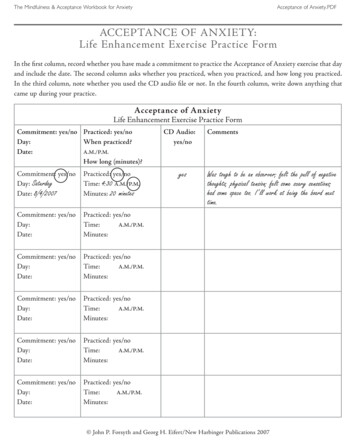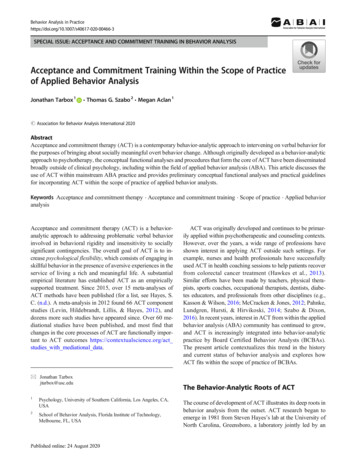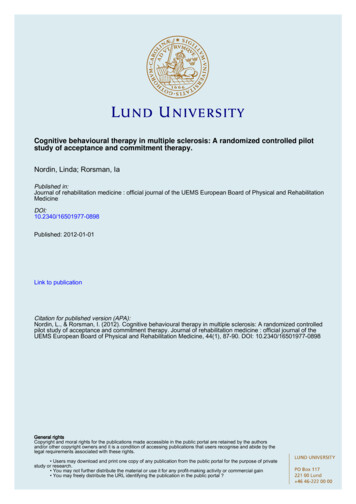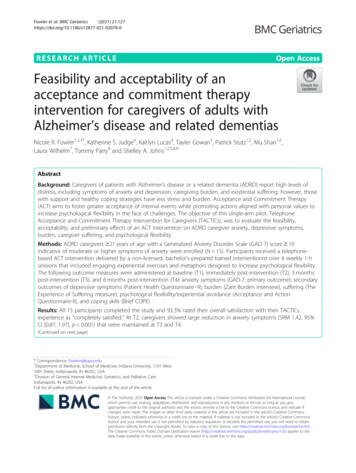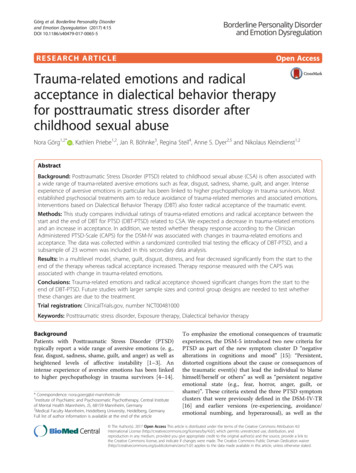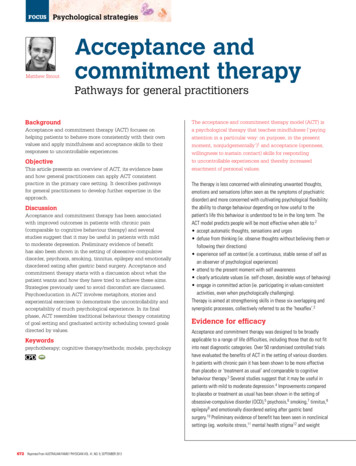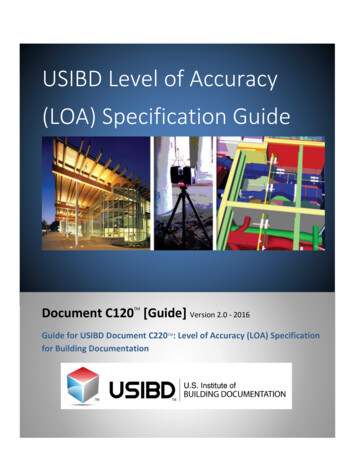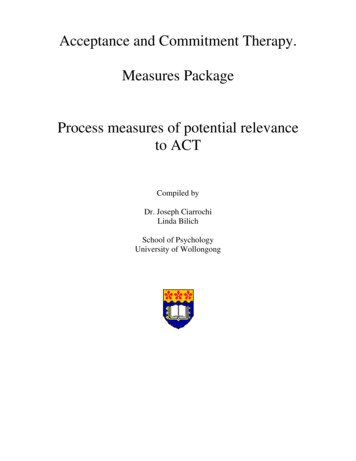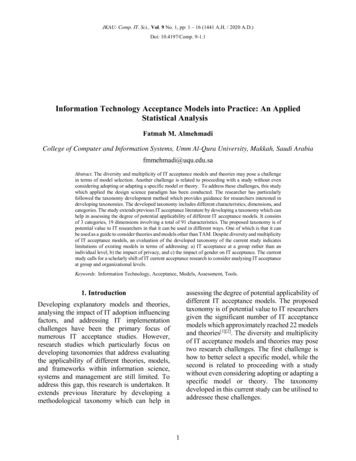
Transcription
JKAU: Comp. IT. Sci., Vol. 9 No. 1, pp: 1 – 16 (1441 A.H. / 2020 A.D.)Doi: 10.4197/Comp. 9-1.1Information Technology Acceptance Models into Practice: An AppliedStatistical AnalysisFatmah M. AlmehmadiCollege of Computer and Information Systems, Umm Al-Qura University, Makkah, Saudi Arabiafmmehmadi@uqu.edu.saAbstract. The diversity and multiplicity of IT acceptance models and theories may pose a challengein terms of model selection. Another challenge is related to proceeding with a study without evenconsidering adopting or adapting a specific model or theory. To address these challenges, this studywhich applied the design science paradigm has been conducted. The researcher has particularlyfollowed the taxonomy development method which provides guidance for researchers interested indeveloping taxonomies. The developed taxonomy includes different characteristics, dimensions, andcategories. The study extends previous IT acceptance literature by developing a taxonomy which canhelp in assessing the degree of potential applicability of different IT acceptance models. It consistsof 3 categories, 19 dimensions involving a total of 91 characteristics. The proposed taxonomy is ofpotential value to IT researchers in that it can be used in different ways. One of which is that it canbe used as a guide to consider theories and models other than TAM. Despite diversity and multiplicityof IT acceptance models, an evaluation of the developed taxonomy of the current study indicateslimitations of existing models in terms of addressing: a) IT acceptance at a group rather than anindividual level, b) the impact of privacy, and c) the impact of gender on IT acceptance. The currentstudy calls for a scholarly shift of IT current acceptance research to consider analysing IT acceptanceat group and organizational levels.Keywords: Information Technology, Acceptance, Models, Assessment, Tools.assessing the degree of potential applicability ofdifferent IT acceptance models. The proposedtaxonomy is of potential value to IT researchersgiven the significant number of IT acceptancemodels which approximately reached 22 modelsand theories[1][2]. The diversity and multiplicityof IT acceptance models and theories may posetwo research challenges. The first challenge ishow to better select a specific model, while thesecond is related to proceeding with a studywithout even considering adopting or adapting aspecific model or theory. The taxonomydeveloped in this current study can be utilised toaddressee these challenges.1. IntroductionDeveloping explanatory models and theories,analysing the impact of IT adoption influencingfactors, and addressing IT implementationchallenges have been the primary focus ofnumerous IT acceptance studies. However,research studies which particularly focus ondeveloping taxonomies that address evaluatingthe applicability of different theories, models,and frameworks within information science,systems and management are still limited. Toaddress this gap, this research is undertaken. Itextends previous literature by developing amethodological taxonomy which can help in1
2Fatmah M. AlmehmadiDeveloping explanatory models andtheories, analysing the impact of IT adoptioninfluencing factors, and addressing ITimplementation challenges have been theprimary focus of numerous IT acceptancestudies. However, research studies whichparticularly focus on developing taxonomiesthat address evaluating the applicability ofdifferent theories, models, and frameworkswithin information science, systems andmanagement are still limited. To address thisgap, this research is undertaken. It al taxonomy which can help inassessing the degree of potential applicability ofdifferent IT acceptance models. The proposedtaxonomy is of potential value to IT researchersgiven the significant number of IT acceptancemodels which approximately reached 22 modelsand theories[1][2]. The diversity and multiplicityof IT acceptance models and theories may posetwo research challenges. The first challenge ishow to better select a specific model, while thesecond is related to proceeding with a studywithout even considering adopting or adapting aspecific model or theory. The taxonomydeveloped in this current study can be utilised toaddressee these challenges.The present study aims at addressing thefollowing objectives: Developing a taxonomy that serves as aframework for reviewing and selecting ITacceptance models which includesdifferent characteristics, dimensions, andcategories. Evaluating the developed taxonomy basedon specific parameters and with referenceto selected IT acceptance models. Conducting a statistical analysis (weightanalysis) on the different characteristics,dimensions, and categories of thedeveloped taxonomy based on IT experts’views.2. Information Technology (IT) AcceptanceModelsPrevious studies that investigated ITacceptance in different countries around theworld have often made use of various modelsand theories. Examples of often cited modelsand theories include The TechnologyAcceptance Model (TAM), Diffusion ofInnovations (DOI) Theory, Unified Theory ofAcceptance and Use of Technology (UTAUT),Theory of Planned Behaviour (TPB), theTechnology–organization–environment Framework(TOE framework), Theory of Reasoned Action(TRA), Delone and McLean IS Success Model(ISS), Task Technology fit model (TTF),Expectation Confirmation Theory (ECT), Usesand Gratifications (U&G) Theory, Big Fivetheory(BIG5),ExtendedTechnologyAcceptance Models (TAM2) and (TAM3),Social Cognitive Theory (SCT), Trust Model,Perceived Value Model, Unified Theory ofAcceptance and Use of Technology (UTAUT2),Social Capital Theory, Inter-organizationalRelationship (IOR) Theory, Flow Theory,Social Identity Theory[1], and The StimulusTheoretical Framework [2].The relative value of these models andtheories is that they can be used to investigatethe impact of different factors that mayinfluence users’ acceptance of informationsystems and technologies[3][4]. This sectionanalyses two of the most popular IT acceptancemodels: TAM and UTAUT. However, readerscan refer to these references [1][2] for an analysisof other models and theories.2.1 Technology Acceptance Model (TAM)The 1985 model of technology acceptanceby Fred Davis is the most widely usedtheoretical model of information systems andtechnologies adoption over the past years [3][5][6].The model could be of importance to futureresearchers who are interested in investigatingusers’ adoption and use of IT in different
Information Technology Acceptance Models into Practice: An Applied Statistical Analysiscontexts. This model suggests that acceptance oftechnology by individuals is determined by twofactors: perceived usefulness and perceived easeof use, and that these two major factors arelikely to be influenced by a number of externalfactors[3][5][7][6][8].It is worth noting that the TAM model hasrun through several modifications over the pastyears [5][9]. The original model has suggestedthat the explanation of users’ motivation toaccept IT is mainly influenced by basic factorsthat represent perceived usefulness, perceivedease of use and attitude towards use, and thesefactors may be affected by other externalfactors[10]. In addition, the model has indicatedthat attitude towards use determines actual use,but it is also influenced by people’s perceptionabout usefulness and ease of use [11]. Asuggested amendment to the original ity may affect users’ attitude towardsusing these systems[12]. Another development ofthe model has been the inclusion of anotherfactor which is the intention to use IT and itsrelationship with perceived usefulness[13]. Themodel points to the potential impact ofperceived usefulness on intentional use andperceived ease of use on perceived usefulnesson people’s acceptance of IT[14][15].However, according to [11], the TAM “haslimitations in being applied beyond theworkplace” and, therefore, “the ability of TAMto apply in a customer context where theacceptance and use of information technologiesis not only to achieve tasks but also to fulfil theemotional needs may be limited”. For additionalcritique of the TAM model see [16][9][11].2.2 The Unified Theory of Acceptance and Useof Technology (UTAUT)This theory was developed in 2003 byVenkatesh[14]. It was based on the conclusionsdrawn from several theories or models whichexplored users’ acceptance of technology[6],3most notably, the following theories: the Theoryof Reasoned Actions (TRA), the TechnologyAcceptance Model (TAM), the Theory ofPlanned Behaviour (TPB), the Using PersonalComputers Model (UPCM), the Diffusion ofInnovation Theory (DOI), and the SocialKnowledge Theory (SKT)[14][11][17]. TheUTAUT includes several variables that mayaffect the intention to use and the actual use oftechnology.As in the previous model (TAM), bothintentional use and actual use are the mostimportant dependent variables in the UTAUT.However, in this theory, these two factors areinfluenced by a different set of independentvariables when compared to TAM. Thesefactors, according to [14][6][11][17], are as follows. Performance Expectancy (PE): the degreeto which people believe that the use oftechnology will improve the functionalityof their work. Effort Expectancy (EE): the degree towhich people believe that the use oftechnology to perform their work will beeasy. Social influence (SI): the degree to whichone believes that others believe that he orshe needs to use technology. Facilitating conditions (FC): the degree towhich people believe that the infrastructurenecessary to support their use of technologyis available and accessible.It should be noted that this theory alsopoints to the potential impact of a set ofintermediate or overlapping variables whichrelate to demographic characteristics of users(gender, age, and prior experiences) on ITadoption and use[18]. The theory assumes thattherelationshipbetweenperformanceexpectancy and effort expectancy and therelationship between social influence and users’intention to use technology will vary according
4Fatmah M. Almehmadito age and gender [14]. On the other hand, thetheory also indicates that the relationshipbetween intention to use, effort expectancy, andsocial influence will differ according to uses’experience, and that the relationship betweensocial influence and intention to use technologywill be different among users’ depending on thedegree of their voluntary use [14][17]. And finally,the theory assumes that the relationship betweenactual use of technology and facilitatingconditions will vary according to users’different age groups and experiences[19] [11].However, some authors such as [18] havesummarized the often cited limitations of thetheory which are associated with not addressingsome factors which may influence users’adoption and use of IT, such as ces, perceived security, perceivedprivacy, and perceived trust. For additionalcritique of the UTAUT see[20][19].3. MethodThe researcher has made use of the designscience paradigm which represents an outcomebased methodology. Outcomes of this paradigminclude a wide range of not only artificialobjects such as human/computer omies, implementation methods, anddevelopment strategies and instruments, butalso presumptions about the setting in whichtheseobjectsare intended tobeused[21][22][23][24][25]. These artificial objects are,therefore, considered knowledge containing[22].According to [26], there are two mainprocesses that characterize the design researchmethodology: Artifact building and artefactevaluation. In relation to this paper, the artificialobject which has been developed represents amethodological taxonomy that can be used forassessing the degree of potential applicability ofdifferent IT acceptance models. The ][28][29][30][31]andparticularlyfollowed the taxonomy development method putforward by [32] which provides guidance forresearchers interested in developing taxonomies.The developed taxonomy includes differentcharacteristics, dimensions, and categories whichare described as follows.3.1 CharacteristicsCharacteristics are often defined as atypical or noticeable feature, quality, or attributethat belongs to people, places, or things andtherefore serves to identify them[33]. In thiscurrent study, characteristics represent a microlevel of analysis and are used to describespecific features that relate to the object underconsideration which is IT acceptance model.These features or attributes include, forexample, country, language, technologystudied, quantitative and qualitative data.3.2 DimensionsAccording to [32], a taxonomy has a set ofa limited number of dimensions. Dimensions inthis study represent a meso level of analysis inthat they are used to group characteristicstogether into one dimension. Thesecharacteristics which represent a micro level inthe taxonomy are grouped together according totheir similar features. Each dimension,therefore, consists of a specific number ofcharacteristics which describe objects underconsideration[32]. The dimension ‘Culture’, forexample, is used to group three characteristicsin the taxonomy which are western, nonwestern, and western vs. non-western.3.3 CategoriesCategories in this study represent a macrolevel of analysis in that they are used to putsimilar dimension together. Thus, each categoryconsists of several dimensions that share similarfeatures and, in particular, that which relate to aspecific area such as context, methodology, andapplication. For example, the category
Information Technology Acceptance Models into Practice: An Applied Statistical Analysis‘Methodology’ is used to put 11 dimensionstogether. These dimensions can be seen in Fig.1, which is shown and discussed in the nextfollowing section.4. Results and Discussion4.1 The Development of the TaxonomyAs stated in the previous section, the stepsthat have been undertaken to develop thetaxonomy include developing characteristics,dimensions, and categories. These stepsrespectively represent three different levels inthe taxonomy: micro, meso, and macro levels.This process has resulted in a methodologicaltaxonomy of IT acceptance models which isshown in Fig. 1 below (C represents Category,D represents Dimension, and CH representCharacterises).As can be seen from Fig. 1, there are 3categories of the taxonomy: context,methodology, and evaluation of degree ofapplicability. In the first category ‘context’,there are 5 dimensions and each dimensionconsists of several characteristics. For example,the dimension ‘culture’ consists of 3characteristics: western, non-western, andwestern vs. non-western, while the dimension‘factors’ consists of 3 characteristics:independent, dependant, and intervening.On the other hand, the category‘methodology’ has the largest number ofdimensions (11) in the developed taxonomy. Anexample of these dimension is researchphilosophy which consists of 4 characteristicswhich are positivist and post-positivist,interpretivist and constructivist, critical theory,and pragmatic. Another example is the dimension‘data source’ which consists of 3 characteristics:primary, secondary, and both. A further exampleis the dimension labelled ‘level of analysis’ whichconsists of 3 characteristics: individual, group,and organisational levels. This dimension can beused to identify the predominant level of analysisthat has been applied in IT acceptance research5and consequently highlight the level which needsmore attention in the future.The final and third category which islabelled ‘evaluation of degree of applicability’can be used to assess the potential suitability ofprevious IT acceptance models and theoriesaccording to three dimensions and a total of 19characteristics. For example, the dimensionlabelled ‘type of application” indicates whethera previous IT acceptance study exactly orpartially replicated a previous model or a theory.It also indicates whether a re-analysis of existingdata has been undertaken or if two or more thantwo models or theories have be incorporated ina study. The two remaining dimensions can beof value for future researchers in that a futurestudy can consider when undertaking. These arerelated to commonly reported limitations andsuggestions for improvement by previous ITacceptance studies.4.2 An Evaluation of the Developed TaxonomyModel Based on Specific Parameters/AspectsThe resulting taxonomy shown in Fig. 1can be used differently depending on thepurpose of its usage. For example, it can be usedto assess the potential applicability of onechosen IT adoption model or theory to addressspecific questions of a given research project.However, it can also be used to conduct asystematic comparison between two or more ITadoption models or theories to help a researcherdeciding whether to adopt/adapt a specificmodel or even proceeding with a study withouteven considering a model or a theory.In order to conduct an evaluation of thedeveloped taxonomy of this study, theresearcher has used 330 previous IT adoptionresearch mentioned in [2], [11], and [1] that relateto the following, often cited, five IT adoptionmodels and theories: TAM TIF UTAUT ECT DOI
6Fatmah M. AlmehmadiFig. 1. Taxonomy or reviewing and selecting IT acceptance models/theories (developed by the researcher of this paper, 2020)(Values in brackets are based on weight analysis).The researcher evaluates the applicabilityof the taxonomy that she has developed in thispresent study by attempting to answer this mainquestion: which model is better to select if agiven study is considering the followingparameters (P), which are based on thedimensions of the developed taxonomy. P1: Health as a subject area
7Information Technology Acceptance Models into Practice: An Applied Statistical Analysis P2: Privacy as an influencing,independent factorP3: Gender as an intervening factorP4: Continuance use as a dependentfactorP5: Internet banking as a technologyfor adoptionP6: Students as a research populationP7: Quantitative method as a researchapproachP8: Meta-analysis as a researchmethodP9: Secondary data as a data sourceP10: Surveys as a data collection toolP11: Statistical approach as a dataanalysis methodP12: Analysing data at a group ratherthan an individual levelThe results of this evaluation process areshown in Tables 1-12 below.4.2.1 An evaluation of the developed taxonomymodel: Health as a subject areaAn evaluation of the developed taxonomymodel to address P1: health as a subject area isshown in Table 1 below.Table 1. An evaluation of the developed taxonomy modelto address P1: health as a subject ectP1: Health as a subject areaxxxxTable 1 indicates that TAM, the UTAUT,DOI theory, and the TIF have more potentialthan the ECT in relation to aspect 1 (i.e.,investigating IT acceptance in relation to healthcontexts). This result is in line with that whichhas been reported in [1], and which points to thesignificance of the above-mentioned models.The implication of this result is that if futureresearchers are interested in exploring ITacceptance in relation to health contexts, thenthey should consider these four models/theories.4.2.2 An evaluation of the developed taxonomymodel: privacyAn evaluation of the developed taxonomymodel to address P2: Privacy as an influencing,independent factor is shown in Table 2 below.Table 2. An evaluation of the developed taxonomy modelto address P2: Privacy as an influencing spectP2: Privacy as aninfluencing, independentfactorxxxTable 2 indicates that TAM, the UTAUT,and the DOI theory have more potential than theTIF and the ECT especially in relation to aspect2 (i.e., investigating the impact of privacy as anindependent factor on IT acceptance). Thisresult is in line with that which has beenreported in [1], and which points to thesignificance of the above-mentioned models.The implication of this result is that if futureresearchers are interested in exploring theimpact of privacy on IT acceptance, then theyshould consider these three models/theories.4.2.3 An evaluation of the developed taxonomymodel: genderAn evaluation of the developed taxonomymodel to address P3: gender as an interveningfactor is shown in Table 3 below.Table 3. An evaluation of the developed taxonomy modelto address P3: Gender as an intervening spectP3: Gender as anintervening factorx
8Fatmah M. AlmehmadiOn contrary to the above results shown inTable 1 and Table 2, Table 3 indicateslimitations of the above-mentioned theoriesexcept UTAUT in relation to addressing aspect3 (i.e., gender as intervening variable). There aretwo implications to this significant result. Thefirst is the need to conduct future research tofurther develop these models/theories to addressthe above aspect. The second implication is thatif a study is interested in exploring the impact ofgender as an intervening factor, then such astudy should consider UTAUT to address thethis factor, or theories other than TAM, DOI,TIF, and ECT since these four models/theoriesdo not adequately address this factor (i.e.,gender).4.2.5 An evaluation of the developed taxonomymodel: Internet banking4.2.4 An evaluation of the developed taxonomymodel: Continuance useIn a similar vein to the result shown abovein table 4, table 5 indicates that TAM, theUTAUT, DOI theory, and the ECT have morepotential than the TIF in relation to aspect 5 (i.e.,investigating IT acceptance with a specialreference to Internet banking as a technology foradoption). This result points to the significanceof the above-mentioned models. Theimplication of this result is that if futureresearchers are interested in exploring internetbanking as a technology for adoption as a topicfor such an investigation, then they shouldconsider these four models/theories.An evaluation of the developed taxonomymodel to address P4: Continuance use as adependent factor is shown in table 4 below.Table 4. An evaluation of the developed taxonomy model toaddress P4: Continuance of use as a rameter/AspectP4: Continuance use as adependent factorxxxxTable 4 indicates that TAM, the UTAUT,DOI theory, and the ECT have more potentialthan the TIF in relation to aspect 4 (i.e.,investigating IT acceptance with a specialreference to continuance use as a dependentfactor). This result is in line with that which hasbeen reported in [1], and which points to thesignificance of the above-mentioned models.The implication of this result is that if futureresearchers are interested in exploringcontinuance using of IT as a dependent factor,then they should consider these fourmodels/theories.An evaluation of the developed taxonomymodel to address P5: Internet banking as atechnology for adoption is shown in Table 5below.Table 5. An evaluation of the developed taxonomy model toaddress P5: Internet banking as a technology ter/AspectP5: Internet banking as atechnology for adoptionxxxx4.2.6 An evaluation of the developed taxonomymodel: Students as a sampleAn evaluation of the developed taxonomymodel to address P6: Students as a researchpopulation is shown in Table 6 below.Table 6. An evaluation of the developed taxonomy model toaddress P6: Choosing students as a TParameter/AspectP6: Students as a researchpopulationxxxxx
Information Technology Acceptance Models into Practice: An Applied Statistical AnalysisTable 6 indicates that TAM, UTAUT,DOI, TIF and ECT share having great potentialin relation to addressing aspect 6. This aspectrelates to investigating IT acceptance bystudents as a research population/sample.However, this result also points to theimportance of more consideration that should begiven to other populations such as children andyoung people, retired employees, and peoplewith special needs (e.g., blind). Such diversityof studied groups will add to previous researchthat greatly focuses on students.4.2.7 An evaluation of the developed taxonomymodel: Quantitative approachAn evaluation of the developed taxonomymodel to address P7: using a quantitativemethod as a research approach is shown in table7 below.Table 7. An evaluation of the developed taxonomy model toaddress P7: using a quantitative method as aresearch /AspectP7: Quantitative method as aresearch approachxxxxxTable 7 indicates that TAM, UTAUT,DOI, TIF and ECT share having great potentialin relation to addressing aspect 7. This aspectrelates to using quantitative method as aresearch approach. However, this result alsopoints to the importance of more considerationof using qualitative methods to investigate ITacceptance to reach a balance with the currentlyoverwhelming quantitative IT acceptancestudies. These qualitative studies can contributeto better understanding of aspects that are notadequately addressed by quantitative studiesthat adopted the above five model/theories suchas aspect 3 (i.e., the impact of gender on ITacceptance) and aspect 8 (i.e., the impact of9privacy on IT acceptance) which arerespectively shown in Table 3 and Table 8.4.2.8 An evaluation of the developed taxonomymodel: meta-analysis as a research methodAn evaluation of the developed taxonomymodel to address P8: using meta-analysis as aresearch method is shown in Table 8 below.Table 8. An evaluation of the developed taxonomy model toaddress P8: using meta-analysis as a ameter/AspectP8: Meta-analysis as a researchmethodxxxTable 8 highlights the significance of theTAM, the UTAUT, and the DOI theory inrelation to aspect 8 (i.e., using meta-analysis asa research method for a study). This result isexpected given the fact that these threemodels/theories are widely used and hence thenumber of previous studies that used thesemodels are more than that which used othermodels (i.e., TIF and ECT). The implication ofthis result is that if future researchers areinterested in conducting a meta-analysis ofprevious IT acceptance research, then theyshould consider these three models/theories(i.e., TAM, UTAUT, and DOI), but also expectto encounter challenges relating to findingenough data if they choose to conduct metaanalysis of previous studies that applied TIFand ECT. For example, a study by [1] reportedthat while TAM has been used in 140 papers,TIF and ECT have been used in 12, and in 8papers, respectively.4.2.9 An evaluation of the developed taxonomymodel: Using secondary data as a data sourceAn evaluation of the developed taxonomymodel to address P9: using secondary data as adata source is shown in Table 9 below.
10Fatmah M. AlmehmadiTable 9. An evaluation of the developed taxonomy model toaddress P9: using secondary data as a data spectP9: using secondary data as adata sourcexxxTable 9 indicates that TAM, the UTAUT,and the DOI theory have more potential than theTIF and the ECT in relation to aspect 9 (i.e.,using secondary data as a data source for aninvestigation of IT acceptance). This resultpoints to the significance of the abovementioned models. This result is expectedgiven the fact that these three models/theoriesare widely used and hence the number ofprevious studies that used these models aremore than that which used other models (i.e.,TIF and ECT). The implication of this result isthat if future researchers are interested inexploring IT acceptance by using secondarydata as a data source for an investigation, thentheyshouldconsiderthesethreemodels/theories (i.e., TAM, the UTAUT, andthe DOI theory), but also should expecting toencounter challenges relating to finding enoughdata if they choose to adopt TIF and ECT.4.2.10 An evaluation of the developed taxonomymodel: Using surveys as a data collectiontoolAn evaluation of the developed taxonomymodel to address P10 using surveys as a datacollection tool is shown in Table 10 below.Table 10 indicates that TIF and ECT sharehaving great potential with TAM, UTAUT, andDOI in relation to aspect 10. This aspect relatesto using surveys to investigate IT acceptance.This result indicates that these fivemodels/theories have a relative flexibilityfeature in terms of methodology.Table 10. An evaluation of the developed taxonomy modelto address P10: using surveys as a data ameter/AspectP10: using surveys as a data collectiontoolxxxxx4.2.11 An evaluation of the developed taxonomymodel: Using statistical approach as adata analysis methodAn evaluation of the developed taxonomymodel to address P11: using statistical approachas a data analysis method is shown in Table 11below.Table 11. An evaluation of the developed taxonomy modelto address P11: using statistical approach as adata analysis method.Models/theoriesParameter/AspectTAMP11: Statistical approach as a dataanalysis methodxUTAUTxDOIxTIFxECTxTable 11 indicates that TIF and ECT sharehaving great potential with TAM, UTAUT, andDOI in relation to aspect 11, which relates tousing statistical approaches for data analysis.This result indicates that these fivemodels/theories have a relative flexibilityfeature in terms of methodology.4.2.12 An evaluation of the developed taxonomymodel: Group as a level of analysisAn evaluation of the developed taxonomymodel to address P12: analysing data at a grouprather than an individual level is shown in Table12 below.
11Information Technology Acceptance Models into Practice: An Applied Statistical AnalysisTable 12. An evaluation of the developed taxonomy modelto address P12: Analysing data at a group ratherthan an individual level.Models/theoriesTAMUTAUTDOITIF
Information Technology Acceptance Models into Practice: An Applied Statistical Analysis Fatmah M. Almehmadi College of Computer and Information Systems, Umm Al-Qura University, Makkah, Saudi Arabia fmmehmadi@uqu.edu.sa Abstract. The diversity and multiplicity of IT acceptance models and t
